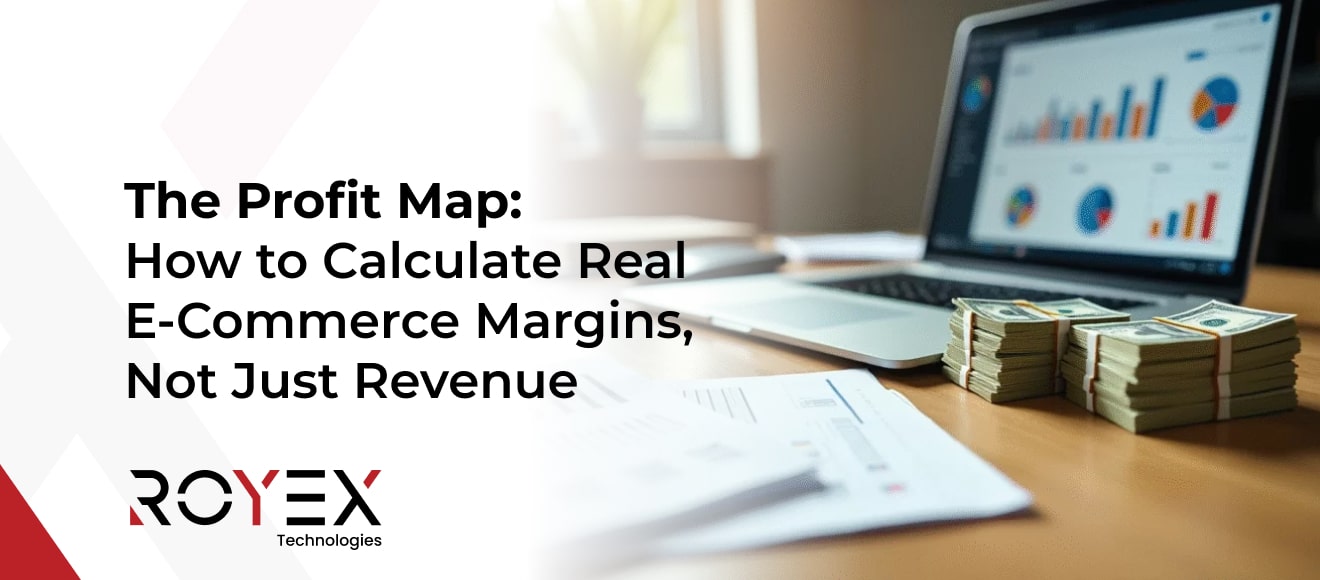
The Profit Map: How to Calculate Real E-Commerce Margins, Not Just Revenue
It’s easy to be dazzled by revenue numbers — six figures a month, seven figures a year — but revenue alone is not the measure of success. What truly defines the health and scalability of your online business is profitability.
In the UAE, where logistics, marketing, and competition all carry premium costs, understanding how to calculate real e-commerce margins can mean the difference between a sustainable business and a cash-draining venture.
This article serves as a complete guide — a profit map — to help you uncover your true profit potential, dissect hidden costs, and align your strategy with sustainable growth.
The Illusion of E-Commerce Success
Every e-commerce owner dreams of hitting AED 1 million in revenue. But what if your profit margin is only 5%? That’s just AED 50,000 — before taxes, fees, and reinvestment.
Statistic: According to a Shopify report, over 80% of new e-commerce entrepreneurs overestimate their profit margins by at least 25% due to hidden operational costs.
Revenue looks glamorous, but real growth lies in optimizing for net profit margins, not just sales.
In the UAE, factors like import duties, delivery logistics, and digital advertising costs can eat away at margins faster than most realize. The goal is to understand the layers between gross revenue and real profit — and this article will break down each.
Understanding the Core of E-Commerce Profitability
Profitability isn’t just what’s left after subtracting expenses. It’s a structured equation involving several key metrics:
-
Gross Profit Margin = (Revenue – Cost of Goods Sold) ÷ Revenue × 100
-
Operating Profit Margin = (Gross Profit – Operating Expenses) ÷ Revenue × 100
-
Net Profit Margin = (Net Profit ÷ Revenue) × 100
Each layer gives insight into where your money is going — from supplier costs to marketing, logistics, and returns.
Example:
If you generate AED 500,000 in monthly sales but spend:
-
AED 300,000 on inventory and logistics
-
AED 100,000 on marketing
-
AED 50,000 on operations
Your net profit is AED 50,000, or just 10% of your total revenue.
The UAE E-Commerce Profit Landscape
The UAE’s e-commerce sector has exploded post-2020, with total online sales expected to exceed USD 9 billion by 2025 (source: Statista). However, profitability hasn’t grown at the same pace.
Here’s why:
-
High logistics costs: Last-mile delivery in the UAE can cost 2–3 times more than in Western markets.
-
Payment gateway fees: Credit card and wallet transaction fees average 2.5–3.2% per order.
-
Intense ad competition: With heavy reliance on Meta and Google ads, CPCs are rising 20–30% year over year.
-
Return rates: Apparel e-commerce return rates average 20–25%, eating into both revenue and logistics costs.
While the UAE market is lucrative, it demands sharper financial control and margin awareness to stay profitable.
Step 1: Calculating Gross Profit Margin
Your Gross Profit Margin (GPM) reflects how efficiently you produce or source products.
Formula:
Gross Profit Margin = (Revenue – Cost of Goods Sold) ÷ Revenue × 100
Example:
-
Selling Price per Item = AED 200
-
Cost of Goods Sold (COGS) = AED 120
-
Gross Profit = AED 80
-
GPM = (80 ÷ 200) × 100 = 40%
Industry Benchmark:
-
Fashion & Apparel: 40–60%
-
Electronics: 10–25%
-
Beauty & Wellness: 50–70%
-
Home Goods: 30–50%
Tip: To improve GPM, negotiate better supplier deals or explore local warehousing to reduce import costs.
Step 2: Identifying Operating Expenses
Operating expenses (OPEX) are the ongoing costs of running your store, including:
-
Website maintenance and hosting
-
Marketing (ads, influencers, SEO)
-
Staff salaries
-
Packaging and delivery
-
Software subscriptions (CRM, email tools, etc.)
Statistic: In the UAE, operating costs typically consume 20–35% of total revenue for small to mid-sized stores.
Example:
If your gross profit is AED 200,000 and operating expenses are AED 100,000, your Operating Profit Margin is:
(200,000 – 100,000) ÷ 500,000 × 100 = 20%
Step 3: Accounting for Hidden and Variable Costs
Many e-commerce businesses fail because they underestimate hidden costs. These are often variable, meaning they grow with sales volume.
Hidden Costs Include:
-
Payment gateway fees: 2.5–3% per transaction
-
Refunds & chargebacks: Average 1–3% of monthly sales
-
Packaging & labeling: AED 1.50–5.00 per package
-
Customs duties: Typically 5% of invoice value for imports
-
Returns: Each returned item can cost 1.5x its delivery cost to process
Statistic: A KPMG UAE study found that logistics and returns alone can reduce margins by up to 15% in e-commerce operations.
To find real profit, factor in these variables before considering your earnings “net.”
Step 4: Marketing Spend — The Double-Edged Sword
Digital marketing fuels growth but can quickly devour profits if not optimized.
Average CPC in UAE (2024):
-
Google Search Ads: AED 4.50–10.00
-
Facebook/Instagram Ads: AED 2.00–6.00 per click
-
TikTok Ads: AED 1.50–4.00
If your conversion rate is 2%, and you spend AED 5 per click, your Cost Per Acquisition (CPA) is AED 250.
Example:
If your product sells for AED 400 with a 40% margin, you earn AED 160. But if your CPA is AED 250, you lose AED 90 per sale.
Statistic: Nearly 68% of UAE e-commerce startups fail to achieve profitability due to unsustainable ad costs.
Solution: Balance paid ads with organic channels — SEO, influencer partnerships, and email marketing — to stabilize your Customer Acquisition Cost (CAC).
Step 5: Understanding Contribution Margin
Contribution margin helps you measure how much each sale contributes to covering fixed costs and profit.
Formula:
Contribution Margin = (Selling Price – Variable Costs) ÷ Selling Price × 100
Example:
Selling Price = AED 200
Variable Costs (COGS + Delivery + Transaction Fees) = AED 150
Contribution Margin = (200 – 150) ÷ 200 × 100 = 25%
This 25% goes toward covering fixed expenses like salaries, rent, and marketing.
Goal: Maintain at least 20–30% contribution margin to sustain long-term profitability.
Step 6: Calculating Net Profit Margin
After accounting for all costs — product, operations, marketing, and returns — you arrive at your Net Profit Margin.
Formula:
Net Profit Margin = (Net Profit ÷ Revenue) × 100
Example:
Revenue = AED 1,000,000
Total Costs (COGS + OPEX + Hidden Costs) = AED 900,000
Net Profit = AED 100,000
Net Margin = 100,000 ÷ 1,000,000 × 100 = 10%
Benchmark:
-
New E-Commerce Businesses: 5–10%
-
Mature Stores with Optimization: 15–25%
In the UAE, 10–15% is a healthy, sustainable profit margin considering higher logistics and payment fees.
The Profit Pyramid: Breaking Down the Journey from Revenue to Net
Here’s how a typical AED 1,000,000 revenue e-commerce business in the UAE might look:
| Stage | Description | Value (AED) | Margin (%) |
|---|---|---|---|
| Gross Revenue | Total online sales | 1,000,000 | 100% |
| Cost of Goods Sold | Product sourcing + shipping | -500,000 | 50% GPM |
| Marketing Spend | Ads + influencers | -200,000 | 30% OPM |
| Operations & Staff | Fulfillment, salaries, software | -150,000 | 15% OPM |
| Returns & Fees | Refunds, chargebacks, duties | -50,000 | 10% NPM |
| Net Profit | Final retained income | 100,000 | 10% Net Margin |
Step 7: Forecasting ROI (Return on Investment)
ROI measures the efficiency of your investment in the business — both time and capital.
Formula:
ROI = (Net Profit ÷ Total Investment) × 100
Example:
If you invest AED 300,000 in website development, inventory, and marketing, and earn AED 100,000 in profit:
ROI = (100,000 ÷ 300,000) × 100 = 33% ROI
Statistic: UAE-based e-commerce businesses that optimize logistics and product mix typically achieve 25–40% ROI within the first 12 months of launch.
Step 8: Improving Margins — The Profit Optimization Framework
-
Reduce COGS: Source directly from manufacturers or negotiate bulk pricing.
-
Optimize Delivery Costs: Partner with 3PLs offering UAE-specific last-mile solutions.
-
Automate Processes: Use ERP systems to cut administrative costs.
-
Upsell & Cross-Sell: Boost AOV through related product bundles.
-
Increase LTV: Implement loyalty programs and subscription models.
-
Data Analytics: Use insights to identify profitable SKUs and stop selling loss leaders.
Statistic: Businesses applying data-driven pricing and automation see up to 22% improvement in profit margins within six months.
Step 9: Evaluating Profitability per Product
Profit isn’t uniform across SKUs. Track individual product performance:
| Product | Selling Price (AED) | COGS (AED) | Delivery (AED) | Ad Cost (AED) | Net Margin (%) |
|---|---|---|---|---|---|
| Item A | 300 | 120 | 25 | 50 | 35% |
| Item B | 150 | 80 | 20 | 40 | 7% |
| Item C | 500 | 200 | 40 | 80 | 36% |
Eliminate low-margin products or bundle them with high-margin ones.
Step 10: The Impact of Scale on Profit
As order volumes grow, economies of scale kick in:
-
Per-unit shipping costs drop
-
Supplier discounts increase
-
Marketing cost per conversion decreases
-
Automation tools reduce labor dependency
However, scaling without margin control can backfire. Always monitor CAC-to-LTV ratio, ensuring LTV is at least 3x CAC.
Step 11: The Psychological Side of Pricing and Profit
Behavioral pricing plays a massive role in profitability. Techniques like charm pricing (AED 99 vs. AED 100) or value bundling can significantly raise conversion rates.
Statistic: A Harvard Business Review study found that strategic price framing can increase conversion rates by 15–25% without cutting margins.
Leverage psychological pricing while maintaining healthy profit per SKU.
Step 12: Real-World Example — UAE E-Commerce Case Study
Case: Home Décor Brand (Dubai)
-
Development cost: AED 180,000 (custom WooCommerce)
-
Monthly revenue: AED 250,000
-
Average order value: AED 450
-
Gross margin: 45%
-
Marketing spend: AED 40,000
-
Logistics and returns: AED 25,000
-
Net profit: AED 37,500 (15% net margin)
Within a year, total ROI exceeded 110%, primarily through localized marketing and delivery optimization.
Step 13: Common Profitability Mistakes
-
Focusing on vanity metrics (revenue, followers) instead of ROI
-
Ignoring hidden fees in payment gateways and shipping
-
Overspending on ads without optimizing conversion rate
-
Poor inventory forecasting leading to stockouts or overstocking
-
Neglecting post-purchase retention channels
Statistic: According to PwC Middle East, retaining just 5% more customers can increase profits by 25–95%.
Step 14: Building a Profit Map for Your Store
Your Profit Map should outline:
-
All fixed and variable costs
-
Gross and net margins
-
CAC vs. LTV
-
Breakeven point
-
ROI timeline
Tool Tip: Use dashboards integrated into your e-commerce system (like those developed by Royex) to track these metrics in real-time.
Why Choose Royex for E-Commerce Development
Royex Technologies has helped hundreds of UAE businesses build scalable, conversion-focused, and profit-optimized e-commerce platforms.
Here’s what sets Royex apart:
-
ROI-Focused Development: Every design, integration, and feature is built to enhance profitability.
-
Local Market Expertise: Deep understanding of UAE consumer behavior, logistics, and payment systems.
-
Seamless Integrations: ERP, CRM, payment gateways, and analytics tools to monitor profit performance.
-
Performance-Optimized Platforms: Fast-loading, mobile-responsive sites that boost conversion and reduce bounce rate.
-
Post-Launch Support: Marketing, maintenance, and analytics assistance to ensure your margins grow consistently.
-
Scalable Architecture: Ready for future expansion across MENA and beyond.
With Royex, you’re not just building an online store — you’re building a profitable e-commerce ecosystem designed for the UAE market. Established in 2013, Royex Technologies is a leading E-Commerce Web Design Company in Dubai that provides innovative solutions for small, medium, and large-scale companies. We specialize in responsive web development, mobile app development, CRM integration, AI solutions for website & mobile applications, and many more. Our extensive experience in mobile app development will help you to take your business to a high level.
Conclusion
Understanding the real economics of e-commerce is the first step to sustainable success. Revenue might impress your followers, but profit is what sustains your business. By analyzing every cost component — from COGS to CAC — and leveraging data-driven decisions, UAE entrepreneurs can build brands that thrive long-term.
Partnering with Royex Technologies ensures your platform is not only beautiful and functional but engineered for profit optimization. Because in the world of e-commerce, success isn’t about how much you sell — it’s about how much you keep.





